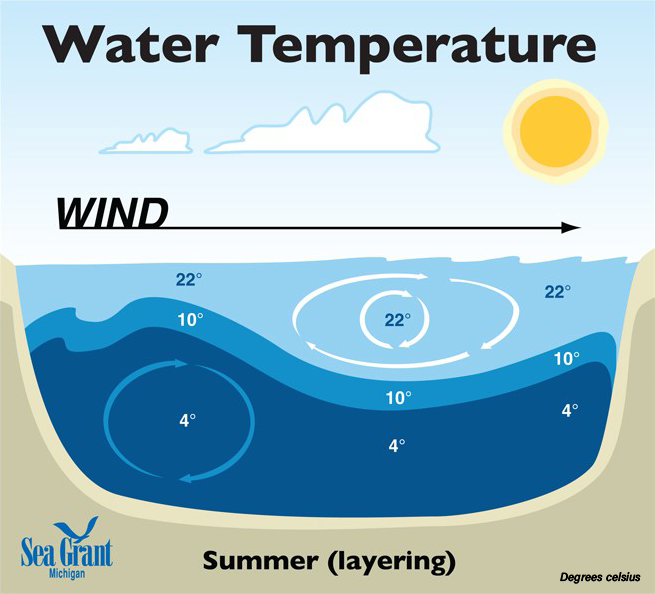Temperature can be measured either as degrees Celsius (°C) or Fahrenheit (°F). Temperature can vary depending on the time of year and the size and depth of a body of water.
An interesting phenomenon for lakes is the stratification of water into layers due to changes in temperature at different depths. These layers occur because as water’s temperature changes so does its density. Water has its highest density at at 4 degrees Celsius. The stratification of a lake typically includes three general layers: the upper, warmer epilimnion; the middle metalimnion (which includes the thermocline); and the lower, colder hypolimnion. In regions that have fluctuating water temperatures (i.e., change of seasons), the layers of water will turn over (known as mixing) due to the change in temperature, and thus density.

The surface layer of water that is constantly mixed by wind and waves and is warmed by the sun, from late spring to lake fall.
The middle layer characterized by a steep gradient in temperature and demarcated by the regions above (epilimnion) and below (hypolimnion). The metalimnion is the barrier that prevents mixing and heat exchange between the epilimnion and hypolimnion.
The deepest layer of uniformly cold water that does not mix with the upper layers and has low circulation. The colder water within the hypolimnion is a maximum temperature of four degrees Celsius.
The temperature of water has a large impact on overall water quality as it directly influences many other parameters. Temperature also is very important to aquatic life.
Temperature influences the amount of dissolved oxygen water can hold (e.g., colder water holds more). Conductivity also increases as the temperature rises. In addition, warmer water makes some substances more toxic for aquatic animals because chemical reactions are usually faster at higher temperatures. Temperature directly influences aquatic life by impacting the rate of metabolism, respiration, photosynthesis, growth, decay, etc. Every aquatic animal has an optimum temperature range that is best for its health.
Temperature naturally varies at different depths and by season. Also, wetland vegetation produces shade, which can cool water. Conversely, when the vegetation is removed, more sunlight can penetrate and warm the water. In addition, erosion can raise water temperature by increasing suspended particles, which absorb the sun’s heat.
Water temperature can be impacted directly by humans by means of thermal pollution and urban runoff. It is common to find thermal pollution near power plants, which use water to cool machinery and then discharge the warmed water back into the waterway. Urban runoff can also increase the temperature of streams, rivers, and lakes when rainwater is heated up on pavement and sidewalks and then runs into a water body.

Limno Loan
c/o Illinois-Indiana Sea Grant
Purdue University
195 Marsteller Street
West Lafayette, IN 47907-2033
Phone: 765-496-6009
Email: iisg@purdue.edu
This program is administered by Illinois-Indiana Sea Grant and funded by the Great Lakes Restoration Initiative via cooperative agreement between the U.S. EPA Great Lakes National Program Office and the National Oceanic and Atmospheric Administration.
© 2023 Illinois-Indiana Sea Grant.
All Rights Reserved.
Illinois-Indiana Sea Grant strives to ensure equal access and an inclusive environment.
Designed by Studio 2D